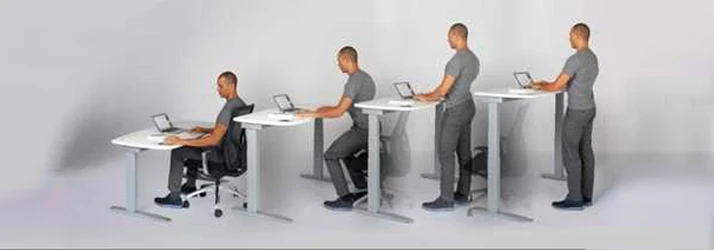Moving Into the New Year in Ellicott City MD

Written by: Brian Morrison, D.C.
Don’t just sit there! “Sitting is the new smoking,” wrote Dr. James Levine in his book, Get Up!: Why Your Chair is Killing You and What You Can Do About It. In an L.A. Times interview, he proclaims: “Sitting is more dangerous than smoking, kills more people than HIV and is more treacherous than parachuting. We are sitting ourselves to death.”
I am frequently asked by patients in Ellicott City MD which chair I recommend for their office or cubical. My reply? “The one you get out of!”
Thus began the era of the standing desk. Was that really the simple solution, the antidote to sedentarianism? According to a report featured on NPR last spring, not really. “An analysis of 20 studies failed to find good evidence that standing at a work desk is better than sitting.” A researcher quoted in the NPR report stated, "What we actually found is that most of it is, very much, just fashionable and not proven good for your health."
Darn. My staff just convinced me that they absolutely HAD to have standing desks or they would die 1000 deaths. I gave in. The report went on: "I would say that there's evidence that standing can be bad for your health." A 2005 study in Denmark showed prolonged standing at work led to a higher hospitalization risk for enlarged veins.
It’s not sitting or standing that are necessarily good or bad, it is our lack of movement and exercise that’s doing us in. The American College of Sports Medicine has a very ambitious program called “Exercise is Medicine” that seeks to educate physicians and bring personal trainers, athletic trainers, exercise scientists, kinesiologists and others into the realm of medicine and health care. Turns out, exercise along with smart dietary choices are probably the most positive changes you can make to benefit your health. Regular exercise prevents ameliorate or even reverses the effects of many degenerative conditions and diseases. Often medication can be reduced or eliminated.
Exercise has been shown to improve your general physical preparedness (G.P.P.). Simply put, regular exercise can maintain or even increase your capacity to perform activities without sustaining injury. As we become sedentary and “age in place,” we lose our capacity to do things. Every summer I see patients who return from their European vacations, having walked the streets of Rome, ascended the steps to the Acropolis r toured the castles of the British Isles with all kinds of “over use” syndromes of their musculoskeletal system. Name an “–itis” – bursitis, tendinitis, fasciitis, myofascitis – and they have it. Many have spent 8-10 hours of the 250 work days a year at a desk then commute an hour home to slump into the couch and watch TV for the evening. That’s how you lose your GPP. People expect their body to behave as it did when they were 25. On vacation they may walk 20,000 steps in a day, lug suitcases and climb stairs. Something has to give….
Beyond GPP, exercise also has remarkable benefits for just about every ailment.
The American College of Sports Medicine tells us that regular physical activity:
- Reduces mortality and the risk of recurrent breast cancer by approximately 50%. Physical activity and survival after breast cancer diagnosis. Holmes MD et al. JAMA 2005; 293:2479; A Prospective Study of Cardiorespiratory Fitness and Breast Cancer Mortality Peel JB, Sui X, Adams SA, Hébert JR, Hardin JW, Blair SN. Med Sci Sports Exerc. 2009 Apr;41(4):742-8.
- Can lower the risk of colon cancer by over 60%. Physical activity and colon cancer: confounding or interaction? Medicine & Science in Sports & Exercise: June 2002 - Volume 34 - Issue 6 - pp 913-919
- Reduces the risk of developing Alzheimer’s disease. Exercise is associated with reduced risk for incident dementia among persons 65 years of age and older. Larsen EB et al.Annals of Internal Medicine 2006; 144:73-81.
- Reduces the incidence of high blood pressure and heart disease by approximately 40%. Cardiorespiratory fitness is an independent predictor of hypertension incidence among initially normotensive healthy women. Barlow CE et al. Am J Epidemiol 2006; 163:142-50 Exercise in the prevention of coronary heart disease: today's best buy in public health.Med Sci Sports Exerc. 1994 Jul;26(7):807-14.
- Lowers the risk of stroke by 27%. Physical activity and risk of stroke in women. JAMA. 2000 Jun 14;283(22):2961-7.
- Reduces the incidence of diabetes by approximately 50%. The association between cardiorespiratory fitness and impaired fasting glucose and type 2 diabetes mellitus in men. Wei M et al. Annals of Internal Medicine. 1999; Reduction in the incidence of type 2 diabetes with lifestyle intervention or metformin. DPP Research Group. New England Journal of Medicine 2002; 346:393-403; The Diabetes Prevention Program Research Group: Within-trial cost-effectiveness of lifestyle intervention or metformin for the primary prevention of type 2 diabetes. DPP Res Group. Diab Care 2003; 26:2518
- Can decrease depression as effectively as Prozac or behavioral therapy. Exercise treatment for depression: efficacy and dose response. Dunn A et al. American Journal of Preventive Medicine 2005
- Reduces cancer-specific specific mortality in adults with higher levels of muscle strength. Muscle strength decreases mortality risk Association between muscular strength and mortality in men. Ruiz JR, Sui X, Lobelo F, Morrow JR, Jackson AW, Blair SN. BMJ 2008; 337:a439. Better to be fit and fat than unfit with lower percentage of body fat. Cardiorespiratory fitness and adiposity as mortality predictors in older adults. Sui X, LaMonte MJ, Laditka JN, Hardin JW, Chase N, Hooker SP, Blair SN. JAMA. 2007 Dec 5;298(21):2507-16.
- Leads to higher academic performance in children and adults. Increased SAT scores. California Dept. of Education Study, December 10, 2002. Fewer disciplinary incidents and fewer out of school suspensions. PE 4 Life Woodland Elementary School, Kansas City PSD #33
- Slows the progression of neurodegenerative diseases like Parkinson’s disease and in some cases medication can be reduced. Ahlskog, J, “Does Vigorous Exercise Have A Neuroprotective Effect in Parkinson’s?” Neurology 77:3, 2011: 288-94.
- Can have a significant impact on chronic pain. Mior, S Exercise in the treatment of chronic pain.Clin J Pain. 2001 Dec;17(4 Suppl):S77-85.
How to Start in Ellicott City MD
Ok, so how do I start? As Nike says, “Just Do It”. Actually brisk walking up to 40 minutes 3-4 times per week is a good goal. If you can only do 10 minutes, don’t sweat it. Start there. Measure how far you can go in 10 minutes. Try to go farther in the same amount of time after you feel comfortable. After that, you can start adding a minute here and there until you reach 40 minutes 4x/week. I highly recommend seeking out a personal trainer, chiropractor or PT who understands any health issues you might have and work with them one on one in a comfortable environment to develop a program and accountability system that works for you. The jury is out about what exercises are best, but you need to break a sweat and feel your breathing rate increase. One of my mentors stated that the best exercise is the one that you’ll do, so find something that attracts your interest and start there.
Prolonged sitting or standing, both can rob us from our health and vitality. Time to move into the new year!
OFFICE HOURS
Monday
7:00am - 7:00pm
Tuesday
7:00am - 7:00pm
Wednesday
7:00am - 7:00pm
Thursday
7:00am - 7:00pm
Friday
7:00am - 12:00pm
Saturday
7:30am - 12:00pm
Every other Saturday
by appointment.
Sunday
Closed
Morrison Chiropractic
2850 N Ridge Rd #107
Ellicott City, MD 21043




